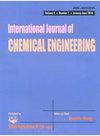Biodiesel Yield and Conversion Percentage from Waste Frying Oil Using Fish Shell at Elmina as a Heterogeneous Catalyst and the Kinetics of the Reaction
IF 2.3
4区 工程技术
Q3 ENGINEERING, CHEMICAL
引用次数: 4
Abstract
In this study, biodiesel was produced from waste frying oil as feedstock with a calcined fish shell under a heterogeneous solid base catalyst. The process of transesterification was done by varying methanol-to-oil molar ratio, catalyst amount, reaction temperature, and reaction time. The heterogeneous catalyst was prepared stepwise as follows: washing and drying the fish shell for 24 hours at 120°C in an oven, then crushing to form powder having been pound for 2-3 minutes in an agate mortar cleaned with nitric acid (6 N). The powdered fish shell was then calcined at 950°C for 4 hours using a muffle furnace. The calcined catalyst was subsequently kept in a desiccator to avoid encountering moisture. The prepared catalyst was then characterized using XRD and FT-IR. The optimum biodiesel yield of 99.58% was obtained under methanol-to-oil ratio of 10 : 1, catalyst amount of 3.0 wt%, reaction temperature of 60°C, and reaction time of 8 hours with mass transfer control of 600 rpm. The optimum rate of constant of 0.164 L/mol·S−1 was determined using the second-order kinetics model. The constant rate of reaction indicated that the forward reaction is crucial for the reaction. The properties of biodiesel produced conformed with those of the international standard using ASTM D6751.以Elmina鱼壳为非均相催化剂从废煎炸油中提取生物柴油的产率和转化率及其反应动力学
本研究以废煎炸油为原料,以焙烧鱼壳为原料,在非均相固体碱催化剂下制备生物柴油。通过改变醇油摩尔比、催化剂用量、反应温度和反应时间来完成酯交换反应。多相催化剂的制备步骤如下:将鱼壳在烤箱中120℃下洗涤干燥24小时,然后在6 N硝酸清洗的玛瑙砂浆中粉碎2-3分钟成粉。然后将粉末状的鱼壳用马弗炉在950℃下煅烧4小时。煅烧后的催化剂随后保存在干燥器中以避免受潮。然后用XRD和FT-IR对制备的催化剂进行了表征。在醇油比为10:1、催化剂用量为3.0 wt%、反应温度为60℃、反应时间为8 h、传质转速为600 rpm的条件下,生物柴油的最佳产率为99.58%。采用二级动力学模型确定了最佳反应速率常数为0.164 L/mol·S−1。反应速率恒定,表明正向反应对反应至关重要。生产的生物柴油的性能符合使用ASTM D6751的国际标准。
本文章由计算机程序翻译,如有差异,请以英文原文为准。
求助全文
约1分钟内获得全文
求助全文
来源期刊

International Journal of Chemical Engineering
Chemical Engineering-General Chemical Engineering
CiteScore
4.00
自引率
3.70%
发文量
95
审稿时长
14 weeks
期刊介绍:
International Journal of Chemical Engineering publishes papers on technologies for the production, processing, transportation, and use of chemicals on a large scale. Studies typically relate to processes within chemical and energy industries, especially for production of food, pharmaceuticals, fuels, and chemical feedstocks. Topics of investigation cover plant design and operation, process design and analysis, control and reaction engineering, as well as hazard mitigation and safety measures.
As well as original research, International Journal of Chemical Engineering also publishes focused review articles that examine the state of the art, identify emerging trends, and suggest future directions for developing fields.
 求助内容:
求助内容: 应助结果提醒方式:
应助结果提醒方式:


